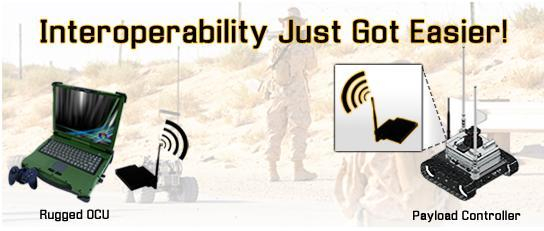At a gathering of unmanned systems professionals, I heard a lot of griping about product development. Trying to deliver a system that the government wants was impossible, because of the time lag. Who knows what the Department of Defense would want or need 2 or 5 years from now? All participants in the meeting agreed that it was the governments’ fault. The Feds simply weren’t telling us what they wanted. Well, it’s not for the lack of trying. It seems every week there’s a new roadmap, report, vision, or long-term plan. I recently reviewed my personal collection of downloaded documents and came up with: Read more
griping about product development. Trying to deliver a system that the government wants was impossible, because of the time lag. Who knows what the Department of Defense would want or need 2 or 5 years from now? All participants in the meeting agreed that it was the governments’ fault. The Feds simply weren’t telling us what they wanted. Well, it’s not for the lack of trying. It seems every week there’s a new roadmap, report, vision, or long-term plan. I recently reviewed my personal collection of downloaded documents and came up with: Read more
Tight budgets = less robots?
The always interesting P.W. Singer had some interesting things to say in his article, “U-Turn: Unmanned Systems Could be Casualties of Budget Pressures” (Armed Forces Journal). In an era of shrinking budgets, he worries that funding for unmanned systems will suffer.
in his article, “U-Turn: Unmanned Systems Could be Casualties of Budget Pressures” (Armed Forces Journal). In an era of shrinking budgets, he worries that funding for unmanned systems will suffer.
“As the Pentagon wrestles with declining overall budget numbers, the new becomes more directly threatening to the old. And in bureaucracies, the old is not only more established, but is often at an advantage in any battle.”
As evidence of his concern, he notes that out of the 25 current costliest Pentagon acquisitions programs, “… there isn’t a single U — for ‘unmanned’ — on the list.” Read more
 The C4ISR explosion
The C4ISR explosion
The need for Command, Control, Communications, Computers, Intelligence, Surveillance and Reconnaissance (C4ISR) is a major force driving the tremendous growth in unmanned systems. C4ISR systems constitute approximately 5% of many national defense budgets. One estimate of global C4ISR market in 2010 is $63.6 billion.
To read the rest of the article, click here.
View to a war
One way that modern warfare mirrors contemporary life is the dependence on Video Display Terminals. All of us have heard stories of warfighters remotely operating unmanned systems while staring at flickering images on computer monitors. Even manned vehicles are sometimes driven by personnel who use computer screens, so as not to expose themselves to hostile fire. Click here to read the rest of the article.
dependence on Video Display Terminals. All of us have heard stories of warfighters remotely operating unmanned systems while staring at flickering images on computer monitors. Even manned vehicles are sometimes driven by personnel who use computer screens, so as not to expose themselves to hostile fire. Click here to read the rest of the article.
Check out this amazing video of a hummingbird UAV from AeroVironment Inc.
This speedy, little UAV illustrates several significant trends in unmanned systems: Read more
If the unmanned vehicles and systems’ community could trade acronyms for  dollars, we’d pay off the national debt. One particular acronym, OPV (Optionally Piloted Vehicles), is popping up all over the place. Northrop Grumman unveiled Firebird, an aerial OPV for intelligence, surveillance and reconnaissance that boasts a 65 foot wingspan. The Army’s Unmanned Aircraft Systems Roadmap outlines plans for helicopters that are both manned and unmanned. The Army also developed Autonomous Vehicle Navigation Systems (ANS) specifically for optionally piloted ground vehicles. Read more
dollars, we’d pay off the national debt. One particular acronym, OPV (Optionally Piloted Vehicles), is popping up all over the place. Northrop Grumman unveiled Firebird, an aerial OPV for intelligence, surveillance and reconnaissance that boasts a 65 foot wingspan. The Army’s Unmanned Aircraft Systems Roadmap outlines plans for helicopters that are both manned and unmanned. The Army also developed Autonomous Vehicle Navigation Systems (ANS) specifically for optionally piloted ground vehicles. Read more
 Part 1 of this series speculated that, contrary to widespread expectations,increased autonomy would make the operation of unmanned systems more difficult, not less. Part 2 explores this hypothesis with David Bruemmer, a well-known authority on autonomy. To read this interview, click here.
Part 1 of this series speculated that, contrary to widespread expectations,increased autonomy would make the operation of unmanned systems more difficult, not less. Part 2 explores this hypothesis with David Bruemmer, a well-known authority on autonomy. To read this interview, click here.
The US Army has announced plans to increase the autonomy of its Unmanned Ground Vehicles (UGVs). “We are moving along that spectrum from tele-operating to semiautonomy where you can send a robot from point A to point B without any intervention,” said U.S. Marine Corps Lt. Col. David Thompson, project manager with the Robotic Systems Joint Program Office (Army building smarter robots). To read the rest of the article, please click here.
Unmanned Ground Vehicles (UGVs). “We are moving along that spectrum from tele-operating to semiautonomy where you can send a robot from point A to point B without any intervention,” said U.S. Marine Corps Lt. Col. David Thompson, project manager with the Robotic Systems Joint Program Office (Army building smarter robots). To read the rest of the article, please click here.
Ground Robotics Capabilities Conference 2011 Report
Mike Castillo, AMREL’s Senior Architect for Robot Applications, just came back from the Ground Robot Capabilities Conference with all sorts of news.
“Research and development is out,” he reported. “Budget priorities have changed. DoD wants existing technologies with a small form factor that’s light and available right now.”
This news made AMREL happy since our product line is mature and even our new solutions are based on proven technologies. For example, at the conference, we successfully demonstrated our new payload controller. Based on the battlefield-tested Flexpedient technology, this payload solution is the first one with interoperable capabilities.
Future blog posts will feature more news about this year’s conference, our new payload controller, as well as other new AMREL solutions.
For more information about Flexpedient and interoperable solutions, watch the video on the Flexpedient page.
AMREL at the Ground Robotics Capabilities Conference
March 22 – 24, 2011 – Orlando, Florida – Booth #112

Flexpedient® Technology now extends existing radio modules’
capabilities to both our OCUs AND payload controllers
Come see AMREL’s latest platforms, including:
- New 986 series laptops with standard Flexpedient device bays
- Atom-based handheld computers & OCUs
- Up-to-minute OCU form factors
To find out about AMREL’s hospitality suite, contact Mike Castillo at:
Office: (626) 443-681, ext 190
Cell: (626) 482-8791
Email: michaelc@amrel.com
American Reliance, Inc.
789 N Fair Oaks Ave,
Pasadena, CA 91103
Office Hours
Monday-Friday:
8:00 am – 5:00 pm PST
Saturday: Closed
Sunday: Closed
Main: +1 (626) 482-1862
Fax: +1 (626) 226-5716
Email: AskUs@amrel.com
Blog Posts
Mobile Biometric Solutions
Mobile Biometric Smartphones & Tablets
BioFlex S® Commercial Smartphones
BioSense AT80B | 8″ Android Biometric Tablet
BioSense PA5 | 10.1″ (Gen 2) Android Biometric Tablet
BioSense PA5 | 10.1″ Android Biometric Tablet
BIOPTIX PM3B | 7″ Windows Biometric Tablet
BIOPTIX PM5B | 10.1″ Windows Biometric Atom Tablet



